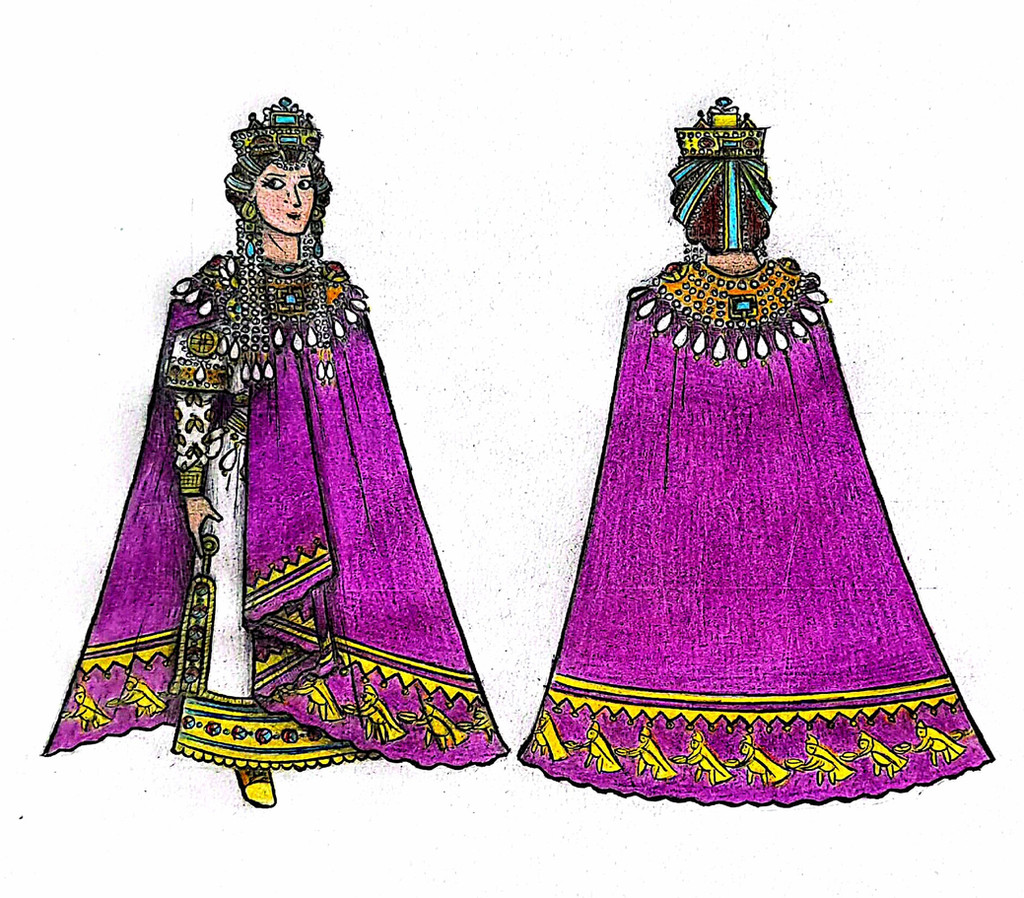HOME | DD
 Avapithecus — Theodora
Avapithecus — Theodora

#byzantine #character #design #empress #history #referencesheet #roman #rome #theodora
Published: 2023-07-22 11:17:05 +0000 UTC; Views: 4450; Favourites: 61; Downloads: 0
Redirect to original
Description
If I could choose one woman from all of history to pluck from the timeline and be my historical waifu, I would have to pick… Cleopatra. When that request inevitably gets shot down, though, the choice is obviously Theodora, wife of Justinian and Empress of Rome. This woman was one of the most intelligent, powerful, and inspiring women in the history of the Roman Empire. Her early life is a bit shrouded in mystery, but it was clearly quite wild. Her father, Acacius, was a bear tamer working in Constantinople's Hippodrome, so we're already off to a great start with this wacky story. She herself had a successful and rather raunchy career as an actress and sex worker (which in ancient Rome were basically considered the same thing), most famous for her… uh… "creative" rendition of Leda and the Swan. Indeed, later in her rule as Empress, Theodora was an outspoken champion of marginalized women throughout the empire. She passed legislation against sex trafficking, created safe houses for sex workers to protect them from predatory brothels, and granted more rights to women in general. She never forgot where she came from, even when a prince in purple entered her parlor in 522.Justinian, nephew of the then-Emperor Justin, was absolutely enamored with this confident young woman, and by all accounts the feeling was mutual. These two lovebirds desperately wanted to get married, but that crusty old Byzantine law forbade Justinian from marrying an actress. This was lame as shit and Justinian begged his uncle to change the law, a demand he eventually caved to in 525. Pretty much as soon as the ink was on paper, Justinian and Theodora wed. When Justin died in 527, Justinian was crowned Emperor of the Romans, with his beloved Theodora as his Empress and closest advisor. By all accounts, Theodora was functionally an equal to her husband, never sitting idle, passing legislation, and taking on court responsibilities when Justinian was absent. Though many in Justinian's court, possibly even including Procopius, our main historical source for this period, saw this as the work of a vile temptress stepping out of bounds for what was expected of a woman, Justinian said… fuck that! He loved his wife and trusted her to his deepest core. She made him feel like anything was possible. Both of them started as commoners and found a way to ascend to the purple of Rome. Indeed, their very marriage represented peace between the two warring factions of Christianity at the time. Justinian was Chalcedonian (the mainline orthodox tradition which held that Jesus was one man who was of two natures: mortal and divine) while Theodora was Miaphysite (or Monophysite, sources differ), a theology which held that Jesus was of one nature: human and divine simultaneously. I know, like me you're sitting there thinking damn, that just makes too much sense. This is the shit people killed one another over back then, though, so having the royal couple come from both sides in true love was an extremely powerful symbol of unity.
In many ways, Theodora was the glue which held Justinian's reign together even when the world threatened to topple it down. In 532, the two competing chariot teams (which back then were sort of mob rule political parties) united under the battle cry of "Nika!" (meaning "Victory!"). I can imagine no greater terror than witnessing two sports rivals suddenly uniting just to kick your ass. I mean hell, imagine the anarchy that would ensue if the Colts suddenly joined hands with the Patriots. Disgusting. Horrifying. On the surface, they united to riot in order to spare the lives of two hanged men (one from each team) who had already managed to survive the gallows. Underneath it, there were some dodgy chess players puppeteering this mess from behind the scenes in order to remove Justinian and his court from power. Justinian, seeing Constantinople in flames thanks to this unstoppable force, wanted to flee. Theodora, however, chastised him and his advisors as cowards. She gave a rousing speech declaring that she'd rather die draped in purple than to have that purple taken away. If Justinian wanted to earn the respect of these hooligans and prevent himself from ever being overthrown again, the most powerful statement he could make would be to stay right here in his city. Justinian, trusting her more than anything, took her advice, and sent out his top general Belisarius to quell the riots and uncover the real masterminds behind the conspiracy. Were it not for Theodora's courage, his reign may have ended right there and then.
She wasn't just a passive voice, either. In 541, when she suspected the tax man John the Cappadocian of being disloyal to the Emperor, she concocted a plan to flush him out. She arranged a secret meeting wherein she pretended to orchestrate a coup against her husband. When John got all elated and was like "hell yeah screw that son of a bitch!", Theodora slapped the cuffs on him and sent him into exile. When the great Plague broke out across the Empire in 542, and whispers circulated that Belisarius might try to usurp an ailing Justinian, Theodora took action. She had nothing against Belisarius, and was friends with his wife even, but her beloved was her responsibility first and foremost. Though Belisarius swore he would never betray his best friend like that, the risk could not be tolerated, and he was removed from his position (though Theodora would later use her friendship with his wife to reinstate him once Justinian recovered). Though both she and Justinian survived the Plague, Theodora would pass from this world in 548, dying of cancer. Justinian was absolutely devastated, weeping at her casket. He refused to marry again, though he had no heir. He simply designated his nephew Justin as his successor, unable to bring himself to betray the love he had for his one and only partner, Theodora.
Design notes, like with Justinian, this piece is pretty much entirely derived from the famous mosaics of the Basilica of San Vitale. It's an absolutely gorgeous piece which depicts Theodora taking charge in the imperial court like the badass girl boss she was. It also seems to be the only contemporary depiction of her there is, or at least it's the only one which every artist and their dog takes inspiration from. To give the composition a little more detail, I supplemented it with some details from Victorien Sardou's 1884 play simply titled Théodora. Specifically, I referenced the costume worn by actress Sarah Bernhardt, mostly for the sleeves. It's kinda fitting how we've come full circle with an actress playing an ancient actress, when you think about it. I think the shape of the cape could use a little tweaking (and that purple really didn't want to get onto the paper without a fight, let me tell ya) but other than that, I'm quite happy with this. She's beautiful, confident, and composed, just like the real deal.
Related content
Comments: 2

👍: 1 ⏩: 1

👍: 0 ⏩: 0
























